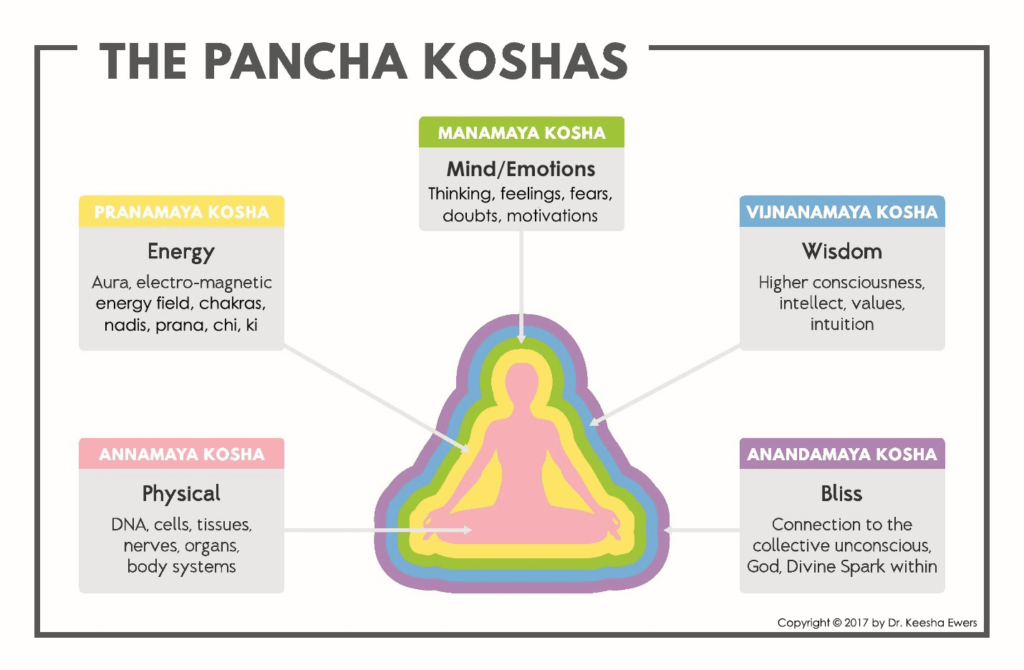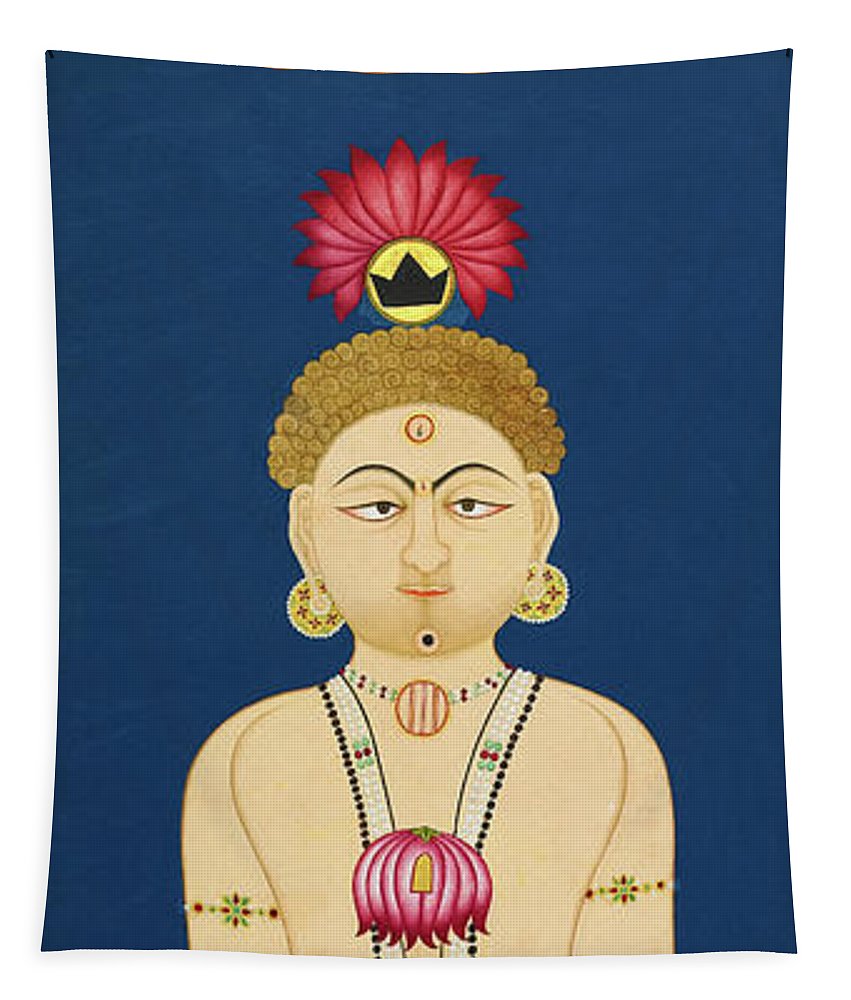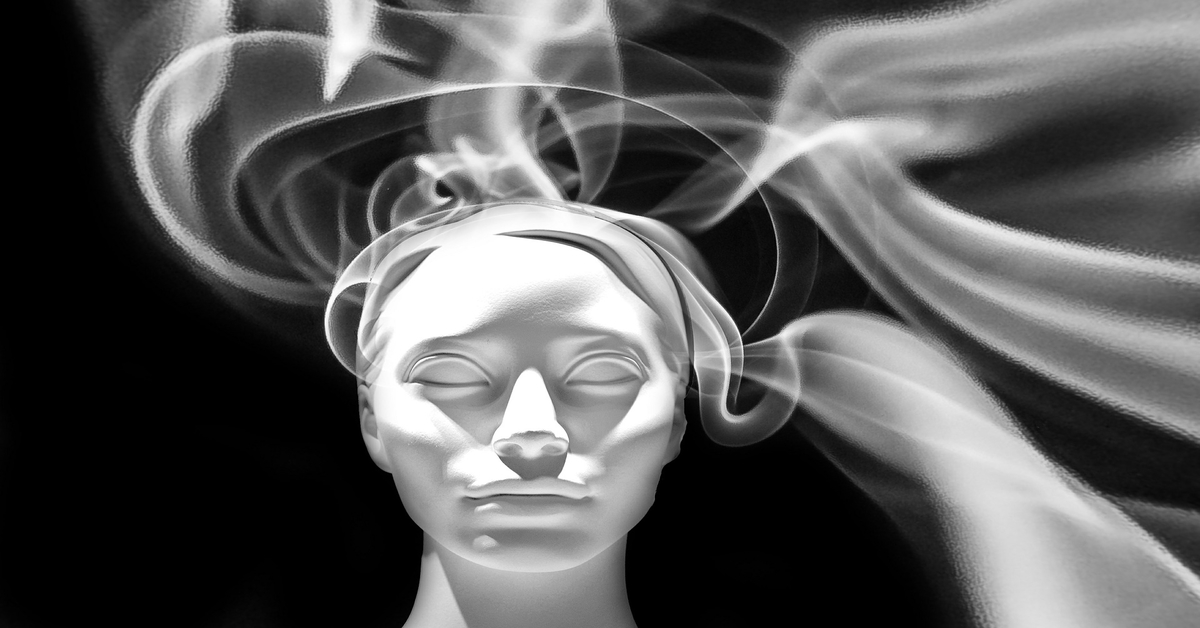Based on Yoga and Ayurveda, humans can experience five dimensions of existence that are called Pancha Kosha or The Five Sheaths. Human awareness can detect these five layers, and each successive layer is more subtle and difficult to penetrate than the previous one.
Pancha Kosha starts with the grossest element (body) and ends with the most subtle element (bliss consciousness).
These Pancha Kosha are:
- Annamya Kosha – The Physical Body Sheath
- Pranamaya Kosha – The Vital Energy Sheath
- Manomaya Kosha – The Mind Sheath
- Vijnanamaya Kosha – The Subconciouss Sheath
- Anandamaya Kosha – The Bliss Sheath
Explanations of each Pancha Kosha are given below:
Vijnanamaya kosha is the link between the individual and the universal mind. The “A-ha” moments or the sudden breakthroughs…

Annamaya Kosha
This is the first layer and the easiest to experience. It is the field of the physical body. The word anna here means “food” and maya means “comprised of.” This layer of existence (our body) is made up of food, water and air. Asanas and physical exercises work on this sheath.
But, this sheath is also heavily dependent on prana.
Pranamaya Kosha
This is the Pancha Kosha and is more subtle than annamaya kosha. It is the energy field of an individual. This energy field supports and pervades the Annamaya Kosha and also all the other Koshas. Prana can be considered as the key that unlocks all other Koshas. It is through purifying and unblocking the flow of Prana (through Yoga and Pranayama) that more subtle koshas can be experienced.
What exactly is Prana?
Prana is considered as the Vital Energy or Force within every created object that is responsible for its existence and material form. It is present in each object whether it is a planet or even a blade of grass. Its first mentions are found in the Yajur Veda and in Taittiriya Upanishad.
It is believed that if there were no prana, there would be no universe. If prana was withdrawn from the universe, then the universe would disintegrate. Prana exists in living and non-living things. A rock that is prayed to by many can exhibit a strong pranic force around it just like a human being can.
The physical body and the pranic body make up the basic human structure called atmapuri: the city of the soul. [1] Pranic Kosha is like the astral or etheric image of the physical body.
According to a verse from Taittiriya Upanishad:

Translation: Verily, besides this physical body, which is made of the essence of the food, there is another, inner self comprised of vital energy by which this physical self is filled. Just as the fleshly body is in the form of a person, accordingly this vital self is in the shape of a person.
The pranic body can also be considered as the aura emanating from a person. Many clairvoyants have claimed to see this luminous cloud around people. Kirlian photography technique (photographic techniques based around capturing electrical coronal discharges) is believed to capture the aura or pranic field around a body.
Though scientists debate about these photographs and believe they are due to the moisture content on the surface and within living tissues [2].
Manomaya Kosha
This is the third sheath and is also known as the mental dimension. It is the seat of our ego or our conscious mind. The very concepts such as “I” or “mine” originate from this kosha. The organs of knowledge, i.e., our abilities of analytical thinking, logical thinking, speech, cognition are part of this kosha.
It acts as the bridge between our outer and the inner world. It conveys the sense impressions of the outer world to our inner intuitions and conscious mind and from our intuitions and will, influences back our gross body.
Vijnanamaya Kosha
This is the fourth layer where our awareness can penetrate. It is called the physic level of experience. It is the seat of our subconscious or unconscious mind. This sphere has its influence spread into the manomaya kosha (conscious mind), but it is a level deeper than it.
Vijnanamaya kosha is the link between the individual and the universal mind. The “A-ha” moments or the sudden breakthroughs and realizations come from this sheath to the conscious mind.
When one has spread his awareness to this sheath and awakened it, the intuitive or psychic powers that many people claim are said to manifest.
Anandamaya Kosha
This is the last and the ultimate layer to be reached. The aim of a yogi is to reside in this layer. This layer is also called as bliss layer, the transcendental layer, or the layer that is the root cause from which all existence pervades. It is the subtlest of the layer. What is beyond this layer, and the exact occurrences that take place in this layer, only an accomplished Yogi can testify.
Residing in this kosha, a yogi is generally believed to be in union with his higher self. Such a yogi can also be identified as a Siddha.

Rising Higher Through the Koshas
The aim of yoga, tantra, and most of the mystical practices across various cultures is to attain a higher level of consciousness. To move through kosha after kosha, purifying and unblocking each level till the Anandmaya kosha is reached.
The various yogic practices that help in this process are:
- Shatkarmas – Purify and strengthens the physical body. So that the awareness can move beyond it and is not be disturbed by the pains and ailments of the body.
- Asanas – Beside affecting the physical body they also affect the pranayama kosha and clear blockages in the flow of vital energy.
- Pranayama Practices – They directly affect the pranayama kosha and indirectly the manomaya kosha.
When all three sheaths are purified and strengthened, they open the door to the fourth sheath, i.e., the Vijnanamaya Kosha (subconscious mind). Psychic and intuitive abilities tend to manifest when this sheath is purified such that it can be easily contacted by will.
The deep-rooted samskaras and impressions start getting purged as the subconscious mind is purified and one can experience extra-sensory perceptions. Creativity and clarity come effortlessly.
When the mind is purged from all impressions and completely emptied, then Anandmaya Kosha is experienced (the blissful emptiness, the state where an accomplished yogi resides).
References
- Book: Prana and Pranayama by Swami Niranjananda
- Research Paper: “Image Modulatic Corona Discharge Photography”.Science. 194 (4262): 263–270
- Book: Hatha Yoga Pradipika by Yogi Swatmarama Muktibodhananda Saraswati
- Book: The Yoga of Breath: A Step-by-Step Guide to Pranayama by Richard Rosen, Rodney Yee, Kim Fraley
- Book: Light on Pranayama: The Yogic Art of Breathing by B. K. S. Iyengar

3 thoughts on “Pancha Kosha: Five Levels of Existence”